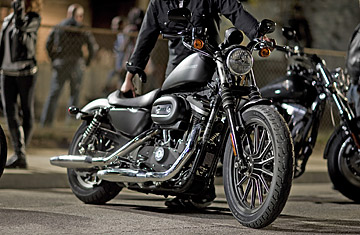
The Harley-Davidson Sportster Iron 883
(2 of 2)
"It reflects individuality and a laid-back cool at the same time," Richer says. The black parts didn't necessarily lower the bike's costs. The developers stood firm on using premium materials, like metal fenders and side covers, rather than the plastic found on comparable bikes. "A lot of our competitors think there's only one way to get through this economy — to go down the price ladder," observes Richer. "But we refuse to play by that book. We have no interest in hurting the long-term value of our brand or our bikes." (See pictures of Evel Knievel, motorcycle stuntman.)
The company's long-term viability will require a focus on more than just pricing. Harley-Davidson must reconsider its dependence on its popular touring bikes — which one industry analyst, Tony Gikas, of Piper Jaffray in Minneapolis, says "look like geezer bikes." To some degree, Harley-Davidson can't dramatically alter the bikes' looks, lest it alienate its core patrons. Nevertheless, Gikas says, "You don't find too many 21- and 22-year-old guys with their girlfriends riding around on Harleys. Or wanting to."
In recent years, many young people have been drawn to sport bikes by Honda, Ducati, Kawasaki and Suzuki. Harley-Davidson also owns a line of products under the Buell brand. But it may make sense to transport some of those products to a new sport-bike line bearing the Harley-Davidson brand, pricing them at roughly the same point as its Sportster line, or less.
Responding to the economic crisis, last month Harley said it would cut production of new bikes this year between 10% and 13%. But analysts like Ed Aaron, of RBC Capital Markets in Denver, say that's hardly enough and that the company's sales projections are overly optimistic. In an interview last week, Bergmann, Harley-Davidson's CFO, said that given the company's plans to shed more than 10% of its workforce and close some factories, "I actually think we're going at it the right way. I think Wall Street will eventually appreciate how we're managing to be proactive throughout this." Even Warren Buffett's move to invest about $300 million in the company failed to inspire much confidence from Wall Street.
Further complicating matters: James Ziemer, a nearly four-decade company veteran who was named CEO in 2005 after having served as CFO, announced plans to leave the post. Bergmann, the current CFO, is considered a candidate to replace him. But the company is likely to choose an outsider with a stronger marketing background to assume the post with a fresh set of eyes to guide Harley-Davidson through its current crisis. (See the 50 worst cars of all time.)
The angst is also rising for Harley-Davidson dealers like Emily Vindeni, of Glendale, Calif. In a typical month, Vindeni sells about 70 bikes at her shop. In January, however, she sold 42. Vindeni recently cut her staff by 10 people, to 65. She's reduced her inventory and lowered prices on some items. The Sportster is usually one of the slowest-selling models, "the ones we're trying to get rid of at the end of the year," she says. But soon after arriving at her showroom, the Sportster Iron 883 sold out. "They've been saying for a long time that it's important to capture the younger generation, but it never seemed to happen," says Vindeni. But the new Sportster, she says, "may help. Even young people dream of owning a Harley."
